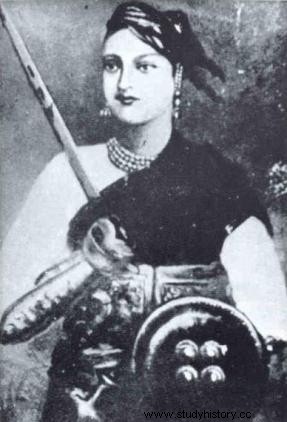Lakshmi Bâî (between 1828 and 1834 – 1858), rânî (sovereign) of the principality of Jhânsi in northern India is a heroine of the revolt of the Sepoys, war of independence and resistance to British colonization. strong>
Annexation of the state of Jhansi
 Lakshmi Bâî was born in Varanasi (northern India) in November, between 1828 and 1834, under the name of Manikarnika, one of the names of the Ganges. She comes from a wealthy family of high officials and receives an excellent education. When she was four years old, her mother died and Manikarnika was brought up in the court of the Peshwa (prime minister), where her father was an adviser. The latter leaves her a fairly free education and, with her brothers, she learns horse riding, archery and the handling of weapons.
Lakshmi Bâî was born in Varanasi (northern India) in November, between 1828 and 1834, under the name of Manikarnika, one of the names of the Ganges. She comes from a wealthy family of high officials and receives an excellent education. When she was four years old, her mother died and Manikarnika was brought up in the court of the Peshwa (prime minister), where her father was an adviser. The latter leaves her a fairly free education and, with her brothers, she learns horse riding, archery and the handling of weapons.
At fourteen, Manikarnika was married to the mahârâja of Jhânsi, Gangâdhar Râo, who was then in his forties. She then becomes râni and takes the name of Lakshmi Bâî. In 1851, she gave birth to a son who died after three months. Two years later, in order to have an heir, Gangâdhar Râo adopts Damodar Râo, the son of a cousin, and makes him his successor. The same year, the raja died and, his heir being a minor, Lakshmî Bâî became regent. But the very powerful British East India Company refused to recognize Damodar Rao, on the grounds that he was not a natural child of the raja, and the Governor-General of India James Broun-Ramsay, Marquess of Dalhousie decided to annex the state of Jhansi. He gives a pension to Lakshmi Bâî and orders him to leave the palace.
The revolt of the Sepoys
In an India where the succession of adopted sons is part of the traditions, this annexation appears to be an injustice. Lakshmî Bâî sends a petition to Dalhousie and then to London. Faced with the failure of these steps, she decides to take up arms. In the spring of 1857, the sepoys' revolt broke out in northern India. On June 8, 1857, employees of the British East India Company were killed by sepoys (soldiers without rank) and Lakshmî Bâî was accused of the massacre. Her role in this event is still unclear, but false testimonies and documents could have been created to discredit her. Without a trial, the British East India Company finds her guilty and raises troops against her. Lakshmî Bâî then brought together an army of 14,000 volunteers, men and women, to reinforce the walls of Jhânsi. The city was attacked by the British in March 1858 and the battle was bloody. After two weeks of siege, a betrayal allows the British to enter the city and perpetrate four days of looting, burning and massacres. At least four to five thousand fighters are said to have been executed during this punitive expedition.
Lakshmî Bâî managed to flee the city by night, with his adopted son and a few guards. In the space of a day, she crosses the desert and travels one hundred and fifty kilometers to reach the fortress of Kalpî where rebel troops live. She manages to convince the leaders to resume the fight and leads several offensives. In Gwalior, the rebels take the city and the fortress before the British arrive on June 17, 1858. Lakshmî Bâî leads the troops into battle, in arms and in men's clothes, but the siege is this time quick and she dies in battle June 18, 1858.
